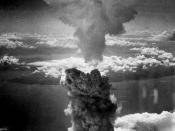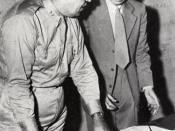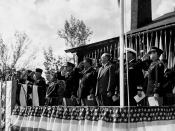Whenever there is a new invention which could strengthen a country, but it is critical to keep it a secret, the government usually takes over. Sometimes, the information is brought to the government first. This was the case with the development of the atomic bomb. The promise and threat of the power of an atomic device were presented to President Roosevelt in a letter signed by Albert Einstein, and its importance was acknowledged by Roosevelt. The seed for the Manhattan Project, as the development of the atomic bomb became called (codenamed Manhattan Engineer District, or MED), was planted. However, knowledge of the United States' new weapon was not to be widespread. The Manhattan Project was kept secret via the top secret designation, compartmentalization, and informing the least number of people.
General Leslie R. Groves headed the Manhattan Project almost from its inception in 1942 until 1947, when atomic energy affairs were turned over to the newly created civilian Atomic Energy Commission.
He was in charge of all phases of it - scientific, technical and process development, construction, production, security and military intelligence of enemy activities,and planning for the use of the bomb.
For about the first year, internal security in the MED was supervised by War Department Counter Intelligence. As far back as February 1942, they and J. Edgar Hoover of the FBI had agreed upon the various phases of security each organization would cover. The War Department's area of responsibility was to include all its civilian employees, as well as all civilians on military reservations or under military control.
It was not until much later in 1943 that a reorientation in the counterintelligence operations of the War Department made it impossible to rely any longer on the centralized organization. The next course of action for the MED was...


